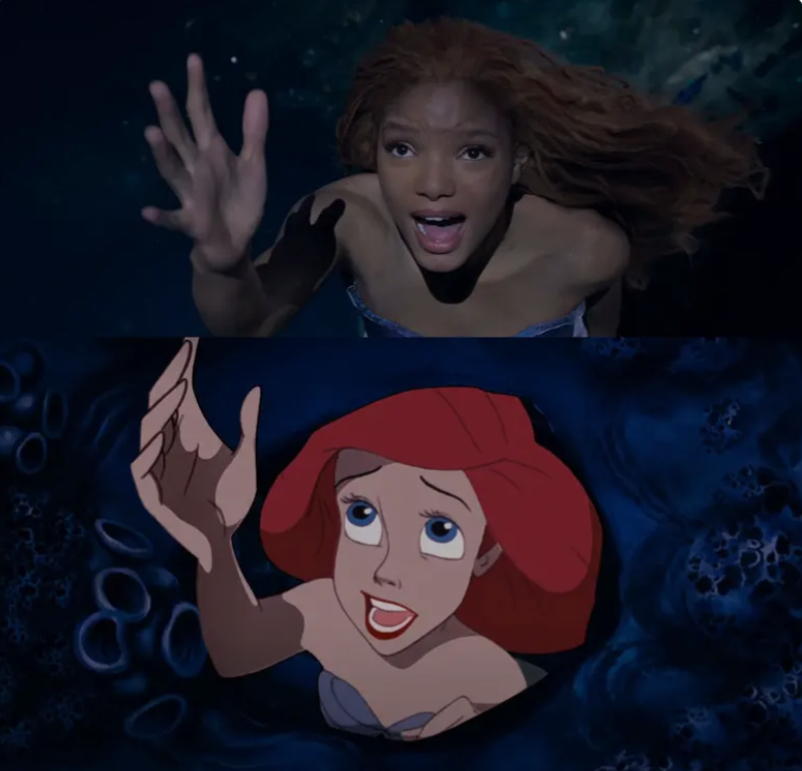In 1989, Ariel was portrayed as a white, red-haired mermaid, symbolic of traditional Eurocentric ideals in Disney animation. This visual norm reflected broader media tendencies to centralise whiteness in narratives, even in fantastical settings like underwater kingdoms (Hurley, 2007). The 2023 live action however casted Halle Bailey, a Black actress, marking a significant shift in the franchise’s approach to representation. This casting generated mixed responses: on one hand, it resonated with audiences seeking more diverse representation, while on the other, it faced backlash from some who felt it diverged too far from the “classic” Disney image. Research in popular communication has noted that racial reimaginings like this one challenge traditional character molds, pushing for a normalised presence of diverse identities in mainstream media (Feng,2020).
Both versions of Ariel retain to the core storyline Ariel’s quest for agency and love but differ in how they handle gender norms. The 1989 Ariel is adventurous but bound by her desire for Prince Eric, reflecting the late 20th century ideal of a “feminine heroine” who’s autonomy is limited by romantic pursuits (stover, 2013). In contrast, the 2023 Ariel is portrayed with an increased sense of agency and personal drive. Dialogue and plot adjustments emphasise her adventurous spirit beyond romantic motivations resonating with contemporary feminist critiques of passive female characters in early Disney narratives (Garabedian, 2015). The live action Ariel is less reliant on Eric, aligning with the “post-feminist Disney Princess” trend that allows more complex character motivations.
These shifts reflect broader societal expectations about inclusion and equality. Disney’s move to feature a Black Ariel encourages audiences to reconsider traditional racial archetypes in media and challenges longstanding stereotypes about who can embody iconic roles (Brode, 2005). Scholars argue that such representation positively impacts self-perception among young audiences of colour, fostering a sense of belonging in spaces historically dominated by Eurocentric imagery (Davis,2006). However, these changes also prompt complex social reactions, including resistance from traditionalists segments, underscoring an ongoing tension between progress and nostalgia in media culture. Furthermore, the 2023 Ariel has inspired diverse audiences to imagine new possibilities within classic tales, showing how reimagining beloved characters can support both self-empowerment and cultural inclusivity.
There are quite a few differences between the little mermaid cartoon vs the live action remake, the most obvious one being that Ariel is black. Halle Bailey, who played the live action remake of Ariel wore her natural locs, which were wrapped with strands of red hair instead of the flat ironed flowing red hair that the cartoon character Ariel had. Another difference I noticed was how realistic flounder the fish looked, from his plump and colourful appearance to a flat and scaly look. In the live action remake the prince is more than just a pretty face, now he is a pretty face but with a backstory something that the cartoon version did not give Eric’s character, in the remake Eric’s trajectory is like Ariel’s he does not feel like he fits in his world. Something that stood out to me in the remake is Ariel killing the sea-witch instead of Eric, this shows a significance of women empowerment and character development in film.
The evolving portrayal of Ariel in The Little Mermaid reflects broader cultural shifts toward inclusivity and agency. The 1989 animated Ariel embodies the post-feminist “damsel-heroine” balancing independence with traditional romantic ideals, while the 2023 adaptation repositions Ariel with greater racial inclusivity and personal agency, challenging stereotypes of race and gender (Stover, 2013; Feng, 2020). This shift responds to increased demand for diverse representation, encouraging audiences to embrace a broader range of identities in media, which fosters greater self-acceptance among young viewers of colour (Harley, 2007). By centralizing a Black Ariel, Disney acknowledges the importance of inclusivity and the positive effects on identity formation for marginalized groups. However, these changes also evoke resistance, illustrating society’s ongoing struggle to balance nostalgia with progressive values. Ultimately, Ariel’s transformation from 1989 to 2023 highlights the potential for beloved stories to evolve alongside changing societal values.
Bibliography
Brode, Douglas. Multiculturalism and the Mouse: Race and Sex in Disney Entertainment. University of Texas Press, 2005.
Davis, Amy M. Good Girls & Wicked Witches: Women in Disney’s Feature Animation. Indiana University Press, 2006.
Feng, Peter X. “Black Ariel: Racebending Disney’s Princess Lineup”. Popular Communication, vol. 18, no 2, 2020, pp. 150-166.
Garabedian, Juliana. “Bringing ‘Magic’ to Life: Disney and the Reification of White Femininity”. Journal of Popular Culture, vol. 48, no. 3, 2015, pp. 482-500.
Hurley, Dorothy L. “Seeing White: Children of Colour and the Disney Fairy Tale Princess”. The Journal of Negro Education, vol. 76, no. 4, 2007, pp. 221-232.
Stover, Cassandra. “Damsels and Heroines: The Conundrum of the Post-Feminist Disney Princess”. Loyola of Los Angeles Women’s Studies Journal, vol. 18, no. 2, 2013, pp. 90-110.


Omotolani
Nicole’s analysis on the comparison of Ariel from the 1989 animated film and the 2023 live-action remake effectively highlights key similarities and differences in character portrayal. Her analysis of Ariel’s quest for agency and love is insightful, particularly in discussing how the 1989 version reflects traditional gender norms while the 2023 version embodies a more modern sense of empowerment. She clearly articulates the evolution from a “damsel-heroine” to a more independent character, which aligns with contemporary feminist perspectives.
Nicole’s main points about racial representation, particularly the significance of casting Halle Bailey as Black Ariel, are well-founded and supported by relevant scholarly sources. Citing works like Feng (2020) and Davis (2006) strengthened her argument about the importance of inclusivity in media and its positive effects on young audiences of color.
However, while she mentions the backlash against the casting choice, her analysis could have benefitted from a deeper exploration of this resistance, perhaps citing examples or public reactions. Additionally, expanding on how the visual differences between the two Ariels reflect their character development; for instance, discussing how the change in hairstyle symbolizes cultural identity could add depth. Providing brief context about historical significance of Disney princesses and their evolution over time would help frame the importance of Ariel’s transformation.
The visual elements of her submissions complemented her analysis well, particularly in showcasing the stark differences in character design and representation. However, it would have been helpful to include a comparison of how each Ariel’s visual depiction relates to their character arcs, emphasizing the significance of these changes beyond aesthetics.
Overall, Nicole presented a compelling examination of Ariels character evolution that effectively engages with contemporary issues of race and gender in media.